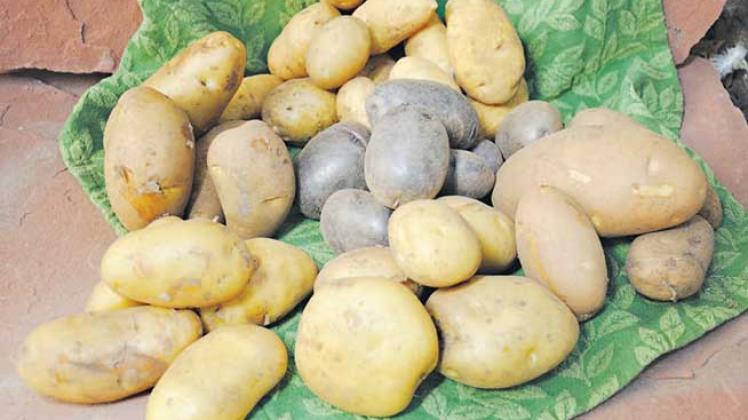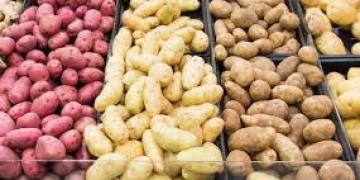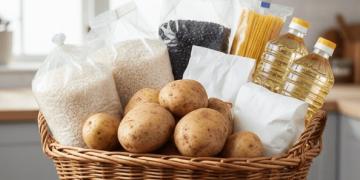Growing potatoes: New fertilizing tricks will boost spud crop
Think the lowly spud is something you put ketchup on and serve as filler? Think again.

Take a close look at the nutrient-packed powerhouse you can grow in your garden. High in potassium, vitamins C and B6 and iron, potatoes got a bad rap when diet gurus declared them off limits, shunning them as just empty calories.
"Anybody who thinks that is full of beans," says David Holm, a Colorado State University professor and potato breeder.
"Potatoes are important in fighting diseases, like cancer or glaucoma; they’re good for you," he says.
Potatoes are fun and easy to grow, plus they’re beautiful, said Samuel Essah, an agronomy professor who works with Holm at the CSU San Luis Valley Research Station.
Together, the duo research and try out promising spuds, looking for a few that will make it to the market.
"A lot of people like heirlooms, they like the nostalgia. Others want new stuff they’ve never seen before," says Verlin Rockey, co-owner with Craig Rockey of the Potato Garden in Austin, a potato purveyor for backyard growers.
"We offer those, plus unusual shapes, colors, and European varieties," says Verlin. The father-son duo purveys an astonishing 85 types of potatoes, including those with a low glycemic index or a high level of antioxidants.
To ensure success they send out seed potatoes with brochure full of growing instructions. The tips are also available at their website, potatogarden.com.
Here are tips from the three experts on spud success.
Choose variety carefully
Let flavor, color and length of growing season guide your picks. Favorite varieties of Holm, Essah and the Rockeys include Colorado Rose, Desiree, or Sangre red potatoes; Nicola or Carola yellow potatoes; Purple Majesty or Midnight Moon purple potatoes, and all-around great russets Canela or Sierra russets.
Short-season potatoes are excellent for gardeners at altitude.
"Those mountain gardeners have the advantage of warm days and cool nights," said Holm. "The potato plant is a factory, taking carbon dioxide and sunlight and converting it to sugar. When temperatures drop at night, it stores it in the tubers, giving them higher-quality solids." What that means in the frying pan is, such potatoes lose less water, so they’ll take up less oil and have a healthier nutrient profile.
Use seed potatoes
Get good, healthy seed stock, not grocery-store potatoes, for the healthiest plants. Let your seed potatoes sit indoors, in medium light, until they develop stocky sprouts from the eyes. Cut the larger potatoes, leaving at least one eye per two-inch square, and let the cuts skin over for a day before planting. If the seed potato is smaller than an egg, plant it whole.
Plant them now
Mid-April through mid-May is ideal potato-planting time. The soil has warmed above 45 degrees, and you’ve got time for the plants to grow plump tubers.
First, it’s good to know what crop was in that spot last. Legumes such as beans or peas leave behind nitrogen that potatoes love. If these veggies were planted in your potato patch last year, go easy on fertilization. It’s a good idea to get a soil test done to determine how much available nitrogen you have.
Build a ridge of loose soil, approximately 6 inches tall, then push the seed 4 to 5 inches deep into the ridge. Space rows 34 inches apart and space the plants 12 to 14 inches apart. Fingerling potatoes can be closer — 9 to 12 inches apart.
As they grow, you’ll hill them up. Just as the potato sprout noses up from the earth, pull the soil up and over the plant, covering it with 7 to 8 inches of soil for a total of 12 inches above the seed. You only need to do this once.
Care and feeding
With potatoes, you need to stay on top of irrigation, checking plants to be sure they aren’t waterlogged. Smaller types take 12 inches of water per season; larger spuds will need 16.
Managing nitrogen is crucial to success with potatoes, Essah says. "Too much and you get a lot of top growth at the expense of tubers." But he also has a secret that makes feeding potatoes easier: It’s all in the timing.
Using his secret involves calculating how much nitrogen your plants need. Each plant only needs a total of one-fifth ounce total nitrogen for the whole season. Go with granular nitrogen to make it easy to measure. For an organic alternative, try Acton, a product the Rockeys developed to provide all the nutrients and beneficial microbes the potato plant needs to thrive.
Essah’s formula is to mix 60 percent of the total amount of nitrogen the plant needs into the soil of the ridge before the seed potato is planted.
Then, about six to seven weeks later, split the remaining nitrogen into two or three applications, approximately two weeks apart. Feeding your plant more nitrogen, too soon, delays tuber set, which means you get a smaller crop of potatoes to enjoy.
To fine-tune the timing on later feedings, check each plant to ensure that tubers have set and and are sizing up by "tickling" them. Reach into the soil and gently feel around the plant’s roots to see if tubers are growing. You want them to be the size of a cherry or larger.
Practice good weed control. The best way is to pluck out weeds by hand, not with a hoe or other weeder, to avoid damaging the baby potatoes.
Get ready to harvest
Potatoes are pretty plants. But to reap your harvest, you’ve got to kill the vines.
To tell if they’re ready, count the days required to maturity of your potato variety (here’s where keeping good garden records helps, but you can also look the variety up online). Then — because plants don’t read websites or labels, tickle up a plant or two to see if the spuds are the size you want. If you’re the impatient sort, see what your records say for your variety about harvesting "new" potatoes. You can always harvest one plant and leave the rest to continue to get bigger.
Chop off vines 14 to 20 days before you want to dig your potatoes, marking the date you did it on the calendar (you’d be surprised what a gardener can forget during the frenzy of harvest). Potato skins toughen up once vines die, which helps them store longer and stand up to a bit of handling.
Fuente: http://www.denverpost.com/homegarden/ci_27882443/growing-potatoes-new-fertilizing-tricks-will-boost-spud




